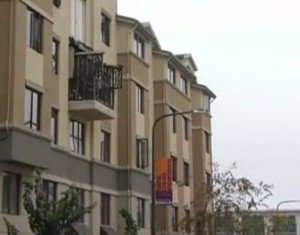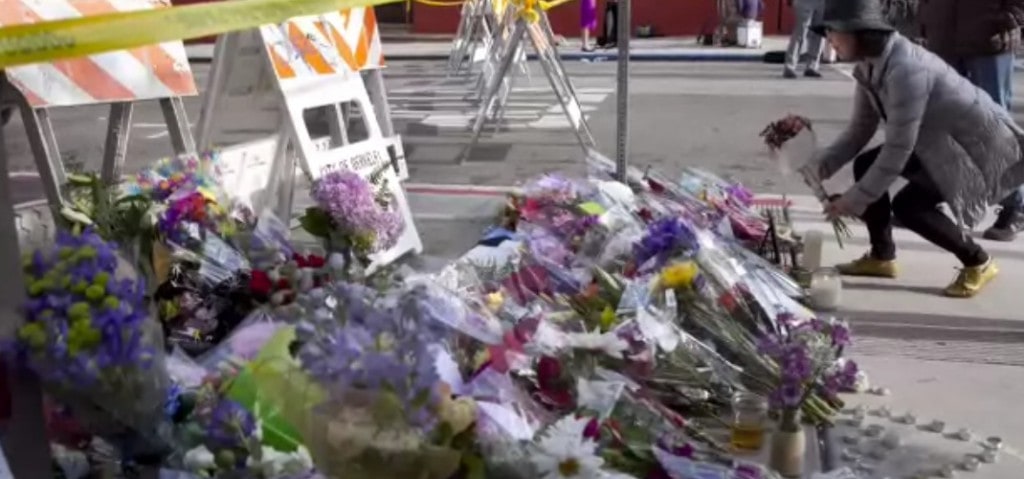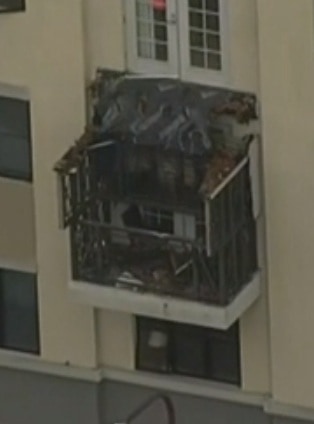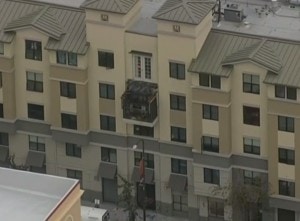There was a birthday party in Berkeley, California. Thirteen guests were out on the fourth-floor balcony when its supports suddenly snapped. It collapsed onto the balcony below, pitching people onto the sidewalk 50 feet down. Four people were killed instantly. Two more died after being rushed to the hospital. Seven were injured, some still in critical condition at this writing.
The San Francisco Chronicle reported the story, adding speculation that the tragic collapse of the balcony on a relatively new building might have been due to dry rot in the support beams. The Los Angeles Times reported the story, also discussing structural issues.
The New York Times reported the story, beginning with and focusing on the work-visa program that allowed many of the dead and injured – mostly Irish students – to come to the US. “Six Deaths In Berkeley Cast Pall On Program,” was the headline.
The second paragraph reads, “But the work-visa program that allowed for the exchanges has in recent years become not just a source of aspiration, but also a source of embarrassment for Ireland, marked by a series of high-profile episodes involving drunken partying and the wrecking of apartments in places like San Francisco and Santa Barbara.” The third paragraph mentions that the neighbors said the accident happened at a “loud party.”
In Ireland, along with the widespread grieving for the dead and injured students, there was anger at the New York Times‘ focus on the program and apparent blame being cast on the victims.
Ireland’s Equality Minister, Aodhán Ó Ríordáin, said “We have six people dead because a balcony collapsed—no other reason. The nature and tone of the article is a disgrace. I think it would be the right thing to do to withdraw that report and apologize.”
Hundreds of complaints poured into the Times, outraged at the victim-blaming aspect to the story. Many also contradicted the idea that Ireland is embarrassed by students who travel on the program.
Apologies quickly followed. First, Eileen Murphy, an NYT spokeswoman said:
This piece was a second-day story following yesterday’s news story of the collapse. It was intended to explain in greater detail why these young Irish students were in the U.S. We understand and agree that some of the language in the piece could be interpreted as insensitive, particularly in such close proximity to this tragedy. It was never our intention to blame the victims and we apologize if the piece left that impression. We will continue to cover this story and report on the young people who lost their lives.
That’s a bad apology. (I don’t care if her name is Eileen Murphy.) The language “could be interpreted as insensitive”? No interpretation needed. Insensitive is precisely what it was. Followed by a fatal sorry-if. “[W]e apologize if the piece left that impression.”
Ó Ríordáin tweeted, “@nytimes Your attempt at an apology for your offensive #berkeley article is pathetic. It’s clearly futile appealing to your better nature.”
Then Margaret Sullivan, the NYT‘s public editor—after reviewing the story, complaints about it, and the preceding apology—did a piece responding to the outcry. She included an explanatory email from the lead writer on the story, Adam Nagourney:
By the time I came on the story, it had already been on our site for five hours or so and we wanted to do something to move it forward. The idea for a second-day story was to focus on the J-1 visa program, and the number of Irish students who, through the program, came here in the summer…
There are obviously positive aspects to the program, which has been a great resource for thousands of young Irish students, as well as negative ones. Looking back, I had the balance wrong; I put too much emphasis on the negative aspects, and they were too high in my story….
Do I think that the program – as well as the problems associated with it – are fair game for a news story? Yes. But there was a more sensitive way to tell the story. I absolutely was not looking to in any way appear to be blaming the victims, or causing pain in this awful time for their families and friends. I feel very distressed at having added to their anguish.
I won’t criticize that as an apology, since I don’t think it’s meant to be one. But I still have criticisms: this story was the first most NYT readers had heard about the tragic deaths, even if it was an old story to the reporters. In their zeal to bring something new to the story, to “move it forward,” they forgot that what it was a story about. People dying.
 Yes, the story got “the balance wrong,” but not because it said too much about alleged negative aspects of the visa program, but because it needed to be a story about thirteen innocent people shockingly killed or harmed.
Yes, the story got “the balance wrong,” but not because it said too much about alleged negative aspects of the visa program, but because it needed to be a story about thirteen innocent people shockingly killed or harmed.
Sullivan, the public editor, also apologized:
A small postscript: I explained several times on Twitter today, and will do so again here, that, as public editor, I don’t write or edit Times stories, or have the power to print a correction or editor’s note. I’m not a part of the newsroom structure, and I don’t speak for the institution, but only for myself. My role is to consider reader complaints, report on them internally, and sometimes comment on them publicly, as I’m doing here. In that role (and as a mother), I can say not only that I believe many of the complaints were valid, but also that I’m very sorry for the pain the story caused.
That’s somewhat better. (Though why “as a mother”?) She validates the complaints, and she apologizes for the pain the story caused, not if it caused pain through being misinterpreted. But she spends a lot of pixels (accurately) saying it wasn’t her fault and that she can’t apologize on behalf of the newspaper. And she doesn’t look hard enough at why the “second day” story was reported that way, nor whether the reporting on the visa program supports the claims.
As for removing the story entirely, which some in Ireland requested, that’s not a thing the NYT does, or that most newspapers do. It sits there as a record of what was said, and in this case, their mistake. That’s legitimate.
Now that SorryWatch has criticized the apologies, let me say a bit more about the story. I find these words and phrases, starting in the first paragraph: raucous life, drunken partying, wrecking of apartments, loud party, revelry, loud party, noise complaint, party central, callous destruction, loaded Irish students, party-hard lifestyle, feel-good, free-spending, noise complaint. As a former J-1 visa recipient wrote to Sullivan, “The only thing missing” from the story was “a picture of a pint and a kid with red hair falling down drunk.”
Loud party? Lots of people attend loud parties. Not just Irish people, not just college-aged people. Parties often get loud.
I am not aware of any nation being embarrassed by the idea that people from their nation may attend loud parties. The Times quoted Irish officials, but none said anything about the national disgrace of loud party attendance. No, they were sad about the deaths. The Irish Ambassador to the US denied the alleged embarrassment, and said the article caused “deep offence.”
There are only two flimsy bits of evidence given toward Irish embarrassment. One comes from a 2014 column in The Irish Voice about some Irish students trashing a rented house in San Francisco. The other is a quote from an Irish student who spent a summer in San Diego through the program, said it was “party central” and he wouldn’t choose to do it twice. Not a damning indictment. Not evidence of national shame.
The story’s focus adds insult to injury. It goes beyond “I was sorry to hear about your mom, but I never liked her” to “I was sorry to hear about your mom, but I never liked her. I always figured you must be so embarrassed by her.”
“To say they [the Times] are unpopular here in Ireland at the moment is an understatement!” says an Irish SorryWatch correspondent.
The latest from the Times is a well-reported story that goes into the heartbreak caused by the accident, and explores construction issues that may have led to the tragedy. It talks about the dead – their aspirations, their friendships – as people, not as possibly drunken partiers allegedly shaming their nation. It’s a good story.
It gives the names of those who died. Olivia Burke. Eoghan Culligan. Ashley Donohoe. Lorcan Miller. Niccolai Schuster. Eimar Walsh.
We’re all so sorry.
Aoife Beary and Hannah Waters are still in critical condition.



Hey, NYT, if you REALLY wanted to move the story forward, you could report (as the Chron did) that the builder has paid out more than $6 million in damages over the last two years alone to settle lawsuits over other balconies on its buildings that were structurally unsound.
$6 million, eh? I expect and hope that 1) they will be put out of business by the payouts for this 2) they will go to jail for negligent homicide or manslaughter.
And, great post, Sumac.
One can imagine the howls of outrage from the Times had some other ethnic or racial group been subjected to this kind of backward stereotyping by any other prominent media outlet. Shame on the Times.
Oh, that is really sad.
I read another paper that remarked — perhaps not in the first piece in that paper on the accident — that the balcony wasn’t meant for thirteen people to stand on it, and I found that inappropriate — but did realize that they’d gotten past the point of, “Oh, no!” to the inevitable journalistic, “Now, how did this happen!?” which is followed immediately by blame.
It’s still just dreadful, on all accounts, and I’m sorry that the NYT tried looking for a bigger story than the loss of six people.
Good point. But the real question then is “If the balcony wasn’t meant to hold that many people, why was it big enough for them?”
I am on board entirely with your story but this comment: not so much. That logic makes no sense to me. You are asking why the balcony was big enough for 13 people, and shouldn’t have been. Does that mean that a balcony meant for one person should only be the width of one person? Lots of people can squeeze into a small car / space / booth: more than probably should. A clear notice inside each apartment indicating maximum weight that balcony could hold should have existed, in addition to the balcony actually having been up to code.
Alas, I think that if you make a cool place to stand and look and wave, people will stand there. Often they won’t pay attention to/notice signs. I think that’s what’s called an “attractive nuisance.”
Also, I fear that if you put notices in apartments saying “No more than 3 people/600 lbs allowed on balcony, whichever is the lesser” you will soon find yourself adding signs that say “No metal in the microwave” “Do not leave the kitchen when something is cooking on the stove” “Do not leave children unattended” and “No bomb assembly permitted” and soon there will be lots and lots of signs to read, which everyone will ignore.
The slippery slope argument hardly seems appropriate here. I would wager that the overwhelming majority of grown adults who are, in the eyes of the law, able to be held fully responsible for their own decisions are well aware that metal does not belong in microwaves. I would bet that nearly every adult of sound mind can recognize bomb-making as an inherently dangerous activity.
I would also bet that only a tiny fraction of adults who are decided to be legally responsible for their own actions could estimate the structural limits of a balcony just by looking at it. As such, it makes perfect sense to inform them. Whether they heed that information is entirely their decision- as I’ve mentioned, in the eyes of the law they are responsible for their own decisions- but that information should at least be made available.
It’s a fairly new building and should not be falling apart. I am embarrassed that American capitalism killed those kids.
Arstad, you’re right. I was being silly with the slippery slope argument. Though here in California every public garage has to display a warning sign that reads “This Area Contains Chemicals Known To The State Of California To Cause Cancer And Birth Defects Or Other Reproductive Harm.” You see why I’m suspicious….
I think you’re also right about the value of a sign saying how much weight a balcony can bear. But I still think balconies need to be designed to support the weight of the number of people who might reasonably stand on it/crowd onto it.
Whoops. “Rueful” above is me.
I’ll add that the reason the balcony collapsed does not seem to have been that there were more people on it than it was designed for, but because shoddy workmanship allowed the support beams to rot.